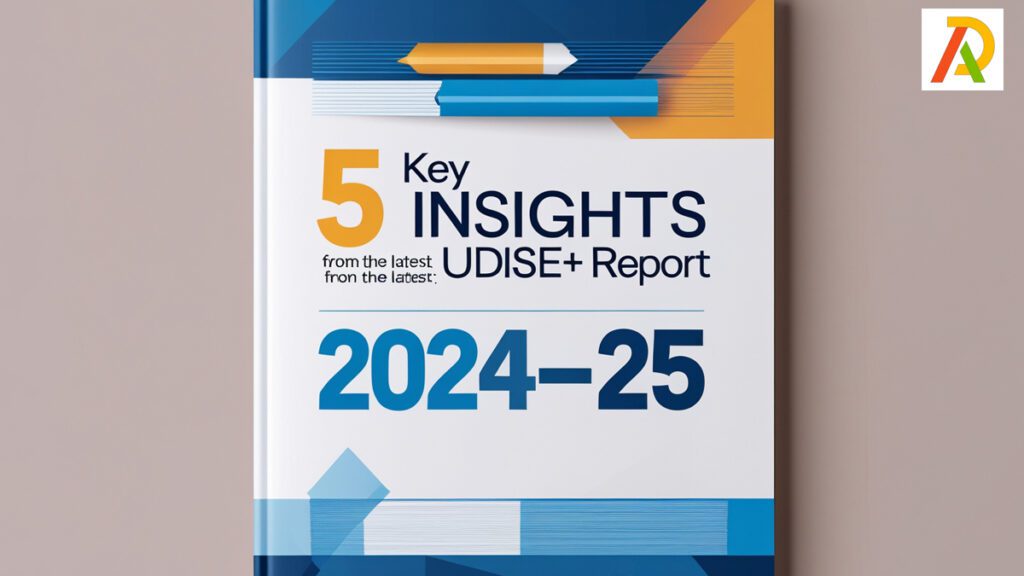5 Key Insights from the Latest UDISE+ Report (2024–25)

India’s school education system is evolving quicker than ever, and the UDISE+ 2024-25 report reflects this transformation inside the numbers and trends that actually be counted. From the energy of teachers crossing new milestones to increasing virtual get right of entry to in classrooms, the modern information from the Education Ministry well-known shows each development and continual demanding situations. Whether you are a teacher, coverage-maker or researcher, expertise those patterns is vital to shaping the future of studying in India. In this newsletter, we highlight five key insights from the UDISE 2024-25 record that shed mild on wherein the device stands these days – and wherein its miles going subsequent. If you are strange with its trends in UDISE and UDISE+ , get started out with our designated evaluation here.
The great and difficult gadget of school education in India is the bedrock of the us of a’s progress. The Ministry of Education, Government of India, administers the Unified District Information System for Education Plus (UDISE+), which offers distinct insights into the status of the world. Data on colleges, enrollment, instructors, and infrastructure nationwide are blanketed within the UDISE+ 2024-25 document, which is released in September 2025. This article offers an analysis of crucial UDISE 2024-25 metrics at the countrywide stage, damaged down into four sections: get entry to, participation, retention, and quality of education.
5 Highlights and Insights from the UDISE+ 2024–25 Report
Before we unpack the data, it is important to note that the UDISE+ 2024-25 report reflects both continuity and change. The developments outlined on this findings aren’t simply numbers – they reflect India’s ongoing attempt in the direction of inclusive, era-pushed and outcome-primarily based education. Let’s explore the five maximum crucial findings that described this yr’s instructional landscape.
Teacher Strength achieves historic feat with improvement in student-teacher ratio
One of the most important highlights of UDISE 2024-25 is the boom within the variety of instructors. For the first time after the launch of UDISE+, the total teaching workforce has crossed 1 crore in the academic year 2024-25.
- The UDISE+ 2024-25 report highlights impressive growth in the number of trainers across India. In 2024-25, the total number of school teachers exceeds 1 crore, which is the first time after the launch of UDISE+. The total number increased significantly from 98,07,600 teachers in 2023-24 to 94,83,294 this year – an increase of 6.7%.
- An important step in improving the student-teacher ratio is this consistent increase. With fewer students per class, each student is getting the individual attention they need.
Insights for educators & policymakers
- Teacher recruitment seems to be choosing up pace; but it’s miles equally critical to make certain that newly recruited instructors are well-trained, deployed to precedence places, and supported with professional improvement.
- While absolutely the numbers are encouraging, distribution matters: rural vs city, faraway vs reachable zones, and topics which include STEM, languages, inclusive schooling.
- With PTRs improving, the focus can increasingly shift from quantity (what number of instructors) to quality (how they train, what outcomes they supply).
- Policymakers need to monitor whether or not this growth in instructor numbers results in advanced studying effects, in preference to in reality assembly numeric goals.
Better Transition and Retention: Fewer Drop-outs, Stronger Progress
Decreases in dropout rates throughout the Preparatory, Middle, and Secondary phases are a particularly encouraging trend in the UDISE+ 2024-25 study.
An encouraging sign of better student retention is this decreased trend that has persisted over time. Nevertheless, although there has been notable advancement, it has been slow and steady. Gradual learning is the hardest part. The inability to keep up with grade-level expectations is a problem that many pupils still face due to gaps in their historical knowledge. If these gaps are not filled, the fall in dropout rates may be more gradual than dramatic.
As a remedy, Personalized Adaptive Learning systems are being developed and put into students’ hands so that they can close achievement gaps and become proficient in their grade. To guarantee that every student not only remains enrolled but also succeeds academically, we must expand and multiply the impact of such innovations in tandem with social sector and government programs.
Enhanced Rates of Student Retention
A larger percentage of students are enrolling and completing their study, according to the UDISE+ 2024-25 report, which shows a marked improvement in student retention rates across the board. The most recent data shows promising improvement over last year:
Level of foundational support: went up from 98.0% in 2023–24 to 98.9% in 2024–25.
Although there is a positive tendency, the growth is small and not fast enough to meet the actual needs. Considerably decrease than the advocated range of ninety-100% is the secondary degree retention rate of 47.2%. These numbers function a reminder that preserving youngsters in college isn’t sufficient; in addition, they need to be studying something precious, grasping ideas, and playing themselves whilst doingit.
Curious and actively engaged pupils are more likely to hold facts once they have got entry to curriculum-aligned, multimodal content that supplements their textbooks. Learning is continued while substances are evolved to fulfill the demands of current newbies in a manner this is interactive, adaptable, and pertinent. Such an intervention, while applied on a massive scale, has the capacity to significantly growth retention fees by using 2026 and past.
Rise in Gross Enrollment Ratio
The Gross Enrollment Ratio has been regularly growing, especially at the secondary and middle college ranges, in keeping with the UDISE 2024-25 observe. This indicates that schooling is turning into more accessible and inclusive.
Although there was an optimistic rising trend, the improvements have been slow and the gaps are nonetheless pretty big. The scenario is mainly dire in secondary schools, where around 1-0.33 of college students aren’t enrolled. This emphasizes the vital requirement of addressing the motives why students do not attend instructions, together with monetary limitations, a lack of stimulating school room settings, and deficiencies in ancient know-how, further to the problem of access.
To reduce this achievement gap, complete strategies are needed, which include enhancing infrastructure, making sure all and sundry has get admission to era, and such as an adaptive getting to know surroundings. Students can be greater inspired to live and increase if that is implemented. This is the best way to ensure that GER increases drastically, reflecting no longer only enrollment but also active engagement and sustained gaining knowledge of.
Reduction in Schools with Zero Enrollment and One Teacher
The decline of schools with zero enrolment or one teacher is another noteworthy accomplishment recognized in the UDISE+ 2024-25 report. These two issues remain in India’s educational system for quite some time.
About 6% fewer schools had just one instructor than the previous year.
There was a precipitous 38% decline in the number of schools with no enrolled students. This trend is really promising. On closer inspection, though, it becomes clear that the problem is far from fixed, even though the numbers are going down. The number of schools with just one instructor is still somewhat high. Likewise, school closures, not actual enrollment improvements, are usually to blame when zero-enrollment schools see a decline.
Improving education accessibility, strengthening teacher availability, and assuring quality learning must be the priority if these disparities are to be truly addressed. Improving schools goes beyond just increasing enrollment and hiring more teachers. It also involves creating a better learning environment, investing in teacher capacity building, and implementing student-driven solutions. This is the only way that the decline in schools with zero or one teacher will lead to real improvements in educational equity and quality for all students, not merely a statistical trend.
Source: https://dsel.education.gov.in/sites/default/files/update/PIB2161543.pdf
UDISE+ 2024-25 Infrastructure Improvements Drive the Gains
Increasing the Number of Schools Equipped with Computers
An essential component of contemporary education, the UDISE+ 2024-25 report emphasizes considerable advancements in school digital infrastructure. In 2024–25, 64.7% of schools had access to computers, up from 57.2% in 2023–24.
Expansion of Online Learning Opportunities in Educational Institutions
From 2023–24 to 2024–25, the percentage of schools with internet access increased dramatically, according to the UDISE+ report, rising from 53.9% to 63.5%. Schools will be able to provide students and instructors access to digital information, online resources, and technology-enabled instructional methods as a result of this upgrade, which indicates a strong emphasis on enhancing digital infrastructure.
Enhancement of School Foundational Infrastructure
Significant development in basic school infrastructure has been highlighted in the UDISE+ 2024-25 report.
Increased enrollment, retention, and transition rates are a direct result of these improvements, which guarantee all kids’ dignity, cleanliness, and safety. As seen throughout the UDISE+ 2024-25 results, improved facilities also directly contributed to higher learning outcomes and overall growth.
Raising the Number of Female Students
Positive developments in the number of female educators and students have been highlighted in the UDISE+ 2024-25 report.
In 2024–25, female instructors will make up 54.2% of the teaching workforce, an increase from 53.3 percent in 2023–24 and 52.3 percent in 2022–23, indicating a strong trend toward gender parity in the classroom.
Enrollment of girls has increased marginally from 48.1% to 48.3%, indicating persistent endeavors to broaden girls’ access to and engagement in education.
Schools should be secure, welcoming, and empowering places for all learners, and this double improvement—in the number of female teachers and the number of female students enrolled—signals a larger commitment to gender parity.
Conclusion
The UDISE+ 2024–25 document paints an encouraging image of India’s schooling panorama — one among progress, promise, and growing responsibility. Teacher strength is rising, dropout costs are falling, and digital infrastructure is progressively increasing. Yet, challenges persist: equitable get admission to, steady nice, and targeted useful resource utilization continue to be vital.
For educators and policymakers, the next step is apparent — circulate from access to achievement, from infrastructure to impact, and from amount to excellent.
India’s school rooms are changing — and if modern developments keep, the UDISE 2025–26 file could mark a good stronger milestone within the state’s training story.


